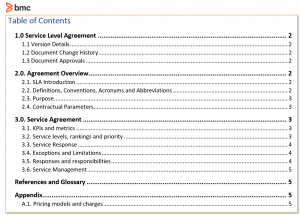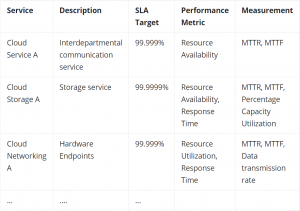Most service providers understand the need for service level agreements with their partners and customers. But creating one might feel daunting, like you don’t know where to start or what to include. In this article, we’re sharing some examples and templates to help you create SLAs.
What is an SLA?
A service level agreement (SLA) is a documented agreement between a service provider and a customer that identifies both the services required and the expected level of service. The agreement varies between vendors, services, and industries.
Before subscribing for an IT service, the SLA should be carefully evaluated and designed to realize maximum service value from an end-user and business perspective. Service providers should pay attention to the differences between internal outputs and customer-facing outcomes, as these can help define the service expectations.
Writing SLAs: an SLA template
The SLA is a documented agreement. Let’s look at a sample SLA that you can use as a template for creating your own SLAs. Remember that these documents are flexible and unique. Make changes as necessary, as long as you include the relevant parties—particularly the Customer. And consider additional topics you may want to add agreements on, such as:
- Review or monitoring. How often the Service Provider and Customer may review the SLA, perhaps annually.
- Service credits. Something the Service Provider may offer in case your SLA is not achieved.
- Rider. Used when amendments occur.
- End-of-contract or liquidation terms. Defining how and when Customer or Service Provider can opt out of the SLA.
There are several ways to write an SLA. Below is a mock table of contents (TOC), which you can use as a starting template for writing your own service level agreements.

Now, I’ll break down each section with a few details and examples.
1.0 Service Level Agreement
The first page of your document is simple yet important. It should include:
- Version details
- Document change history, including last reviewed date and next scheduled review
- Document approvals
| Document details & change history | |||
| Version | Date | Description | Authorization |
| … | … | … | … |
| Document approvals | |||
| Name | Role | Signature | Date |
| … | … | … | … |
Last Review: MM/DD/YYYY
Next Scheduled Review: MM/DD/YYYY
2.0. Agreement Overview
The next section, the agreement overview should include four components:
- SLA introduction
- Definitions, convention, acronyms, and abbreviations (A glossary)
- Purpose
- Contractual parameters
2.1. SLA Introduction
Include a brief introduction of the agreement, concerning parties, service scope and contract duration. For instance:
This is a Service Level Agreement (SLA) between [Customer] and [Service Provider]. This document identifies the services required and the expected level of services between MM/DD/YYYY to MM/DD/YYYY.
Subject to review and renewal scheduled by MM/DD/YYYY.
Signatories:
2.2. Definitions, Conventions, Acronyms, and Abbreviations
Include a definition and brief description terms used to represent services, roles, metrics, scope, parameters, and other contractual details that may be interpreted subjectively in different contexts. This information may also be distributed across appropriate sections of this document instead of collated into a single section.
| Term | Description |
| SLA | Service Level Agreement |
| Accuracy | Degree of conformance between a result specification and standard value. |
| Timeliness | The characteristic representing performance of action that leaves sufficient time remaining so as to maintain SLA service expectation. |
| IT Operations Department | A unit of [Customer] responsible for internal IT Operations. |
| … | … |
2.3. Purpose
This section defines the goals of this agreement, such as:
The purpose of this SLA is to specify the requirements of the SaaS service as defined herein with regards to:
- Requirements for SaaS service that will be provisioned to [Customer]
- Agreed service targets
- Criteria for target fulfilment evaluation
- Roles and responsibilities of [Service Provider]
- Duration, Scope and Renewal of this SLA contract
- Supporting processes, limitations, exclusions and deviations.
2.4. Contractual Parameters
In this section, you’ll want to define the policies and scope of this contract related to application, renewal, modification, exclusion, limitations and termination of the agreement.
This section specifies the contractual parameters of this agreement:
- Contract renewal must be requested by [Customer] at least 30 days prior to expiration date of this agreement.
- Modifications, amendments, extension and early termination of this SLA must be agreed by both signatory parties.
- [Customer] requires a minimum of 60 days’ notice for early termination of this SLA.
- …
3.0. Service Agreement
This section can include a variety of components and subsections. into the following components:
- KPIs and metrics
- Service levels, rankings, and priority
- Service response
- Exceptions and limitations
- Responses and responsibilities
- Service Management
3.1. KPIs and Metrics
Key performance indicators (KPIs) and other related metrics can and should support your SLA, but the achievement of these alone does not necessarily result in the desired outcome for the customer.
| Metric | Commitment | Measurement |
| Availability | MTTR | |
| Reliability | MTTF | |
| Issue Recurrence | ||
| … | … | … |
3.2. Service Levels, Rankings, and Priority
| Severity Level | Description | Target Response |
| 1. Outage | SaaS server down | Immediate |
| 2. Critical | High risk of server downtime | Within 10 minutes |
| 3. Urgent | End-user impact initiated | Within 20 minutes |
| 4. Important | Potential for performance impact if not addressed | Within 30 minutes |
| 5. Monitor | Issue addressed but potentially impactful in the future | Within one business day |
| 6. Informational | Inquiry for information | Within 48 hours |
| … | … | … |
3.3. Service Response

3.4. Exceptions and Limitations
Include any exceptions to the SLA conditions, scope, and application, such as:
This SLA is subject to the following exceptions and special conditions:
- [Service Provider] must ensure Cloud Service A availability of 99.9999% during holiday season dated MM/DD/YYYY to MM/DD/YYYY.
- [Service Provider] may not be liable to credit reimbursement for service impact to data centers in Region A and Region B due to natural disasters.
- Response to requests of Severity Level 6 or below by [Customer] can be delayed up to 24 hours during the aforementioned holiday season.
- Requests for special arrangements by [Customer] may be expedited as per pricing structure specified in Appendix A.1.
3.5. Responses and Responsibilities
Here, you’ll define the responsibilities of both the service provider and the customer.
[Customer] responsibilities:
- [Customer] should provide all necessary information and assistance related to service performance that allows the [Service Provider] to meet the performance standards as outlined in this document.
- [Customer] shall inform [Service Provider] regarding changing business requirements that may necessitate a review, modification, or amendment of the SLA.
- …
[Service Provider] responsibilities
- [Service Provider] will act as primary support provider of the services herein identified except when third-party vendors are employed who shall assume appropriate service support responsibilities accordingly.
- [Service Provider] will inform [Customer] regarding scheduled and unscheduled service outages due to maintenance, troubleshooting, disruptions or as otherwise necessary.
- …
3.6. Service Management
Include service management and support details applicable to the service provider in this section
3.6.1. Service Availability
Service coverage by the [Service Provider] as outlined in this agreement follows the schedule specified below:
- On-site support: 9:00 A.M. to 6:00 P.M, Monday to Friday between January 5, 2020 to December 20, 2020.
- Phone Support: 24-Hours as per Section 3.2. of this agreement.
- Email Support: 24-Hours as per Section 3.2. of this agreement.
- …
References and Glossary
Include reference agreements, policy documents, glossary and relevant details in this section. This might include terms and conditions for both the service provider and the customer, and any additional reference material, like third-party vendor contracts.
Appendix
The appendix is a good place to store relevant information that doesn’t fit elsewhere, such as pricing models and charges. The following section is an example of information you may want to append to your SLA.
A.1. Pricing models and charges
Include the pricing models for each service type with detailed specifications.
| Service | Capacity | Type – Throughput | Price |
| Cloud Storage A | |||
| Option | |||
| A | 500GB | HDD – 250 MB/s | $5.00/Mo |
| B | 10TB | SSD – 500 MB/s | $10.00/Mo |
| C | 50TB | SSD – 1000 MB/s | $15.00/Mo |
| Additional Storage | |||
| A.1 | 100GB | HDD – 250 MB/s | $1.00/Mo |
| B.1 | 2TB | SSD – 500 MB/s | $2.00/Mo |
| C.1 | 10TB | SSD – 1000 MB/s | $4.00/Mo |
| … | … | … | … |
SLA best practices
Though your SLA is a documented agreement, it doesn’t need to be lengthy or overly complicated. It is a flexible, living document. My word of advice? Build one using this template and examples and consult with your customers for any perceived gaps. As unforeseen instances are inevitable, you can revisit and tweak the SLA as needed.
Additional resources
Additional SLA templates and examples are available here:






